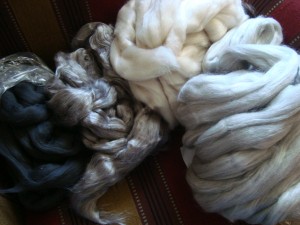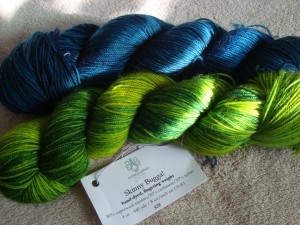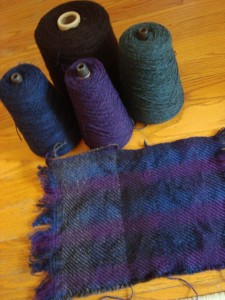Mon 21 Oct 2013
Rhinebeck 2013 was a quiet affair compared with the past couple of years. Without the previous convergence of friends from all over, it was a much shorter, simpler occasion. Branden and I drove out on Saturday morning, spent a couple of hours browsing the market, and then came home. We stopped at WEBs on the way back, and looked at looms. (Branden is working hard to enable a wider floor loom, which I have been dithering about for several years but haven’t acted on yet. Someday. Maybe soon.)
Of course, being me, I walked into the festival and instantly developed camnesia. Since Branden’s camera batteries were also unexpectedly dead, I have no pictures to show for myself. so words will have to do instead.
Every year, I try to come up with a couple of general categories of things to look for ahead of time. These things often change once I actually start shopping, but I like to go into the market with a theme in mind. After that, I just look for things that jump out and demand to come home with me.
This year’s theme was luxury fibers. I am perennially cold, and often walk around the house in wool slippers, a heavy wool sweater and scarf, and sit huddled up under a blanket when Branden is walking around in a t-shirt and feeling a little warm. Luxury fibers are often even warmer than wool, and that’s been sounding really attractive lately. I’ve also been focusing on making garments for work, and a little luxury helps to dress things up a bit.
Of course, I drooled a bit over the qiviut, but my cheap side (and love of large projects) won out and there was no qiviut this year. Of all the fibers I petted, cashmere was the one that was calling the most, but I didn’t find anything that quite fit all of the parameters. I have a scarf that I knit many years ago that is part cashmere, and it has worn beautifully and is wonderfully soft and warm. I’ll keep a weather eye out for the right yarn, but nothing popped out at me this year.
In the end, I decided to buy things that I can spin first. It’s always better to have two luxury projects for the price of one, right? For not much more than the price of a 200-yard skein of qiviut, I ended up with 8 oz of a 40/40/20 baby camel/wool/tussah blend, 8 oz of 70/20/10 wool/yak/tussah, and 4 oz of yak/bombyx top. Add to that a few ounces of carbonized bamboo, and I’d say that I have enough to keep me busy for a little while.
Of course, it’s always important to leave room for the unplanned things, too. On our first pass around the market, I saw someone with a skein that just leaped out at me. It’s a color that’s been gradually growing on me lately, and the yarn absolutely glowed.
The only other time I’ve seen a dye job this compelling was in a skein of Sundara silk that someone had knit into a shawl at the knitting guild in Madison. It was absolutely beautiful, and I’ve always hankered to spend a little time getting to know that kind of yarn a little more closely, in hopes that some of the dyeing skill will seep through into my fingers. I ended up with 2 skeins of Bugga from Cephalopod yarns, and I can’t wait to see what they decide to become.
Aside from that, I picked up a couple of cones of weaving yarn for the weft of a project that I’d just put on the loom.
The warp is a huge skein of Kauni that I bought while we were in Germany, which had a brief and ill-fated existence as a raglan sweater and has been relegated to the stash ever since. I’ve been intending to weave with it forever, but just hadn’t gotten around to it yet. When I emptied the loom a couple of weekends ago, I wound up the Kauni and put it right on. I tried some of the wool that I had in my stash as a weft yarn, but it was too light a gray and ended up washing out the colors of the Kauni stripes (on the left, in the photo above). So, I picked up a few options of Shetland cone colors at the Harrisville booth. I thought I wanted black, and almost didn’t buy the blue and the purple, but I’m very glad that I did! The black also overwhelmed the warp stripes, and I ended up going with the purple weft, much to my surprise. That’s the one I’d have left on the shelf if I’d had to choose, too. It just goes to show that you never can tell what you need until you try it (especially with weaving, I find!).
And there you have it: Rhinebeck 2013. I wore the Fall Colors sweater, complete with newly worked sleevecaps, and got several compliments on it, which was nice. Due to aforementioned camnesia, I have no modeled photos to show you, but we’ll try to remedy that soon. It’s a year later than I expected it to be, but it did turn out to be a Rhinebeck sweater after all!
And now, I’m off to spin up some batts and make my spinning wheel available for some luxury fibers.


